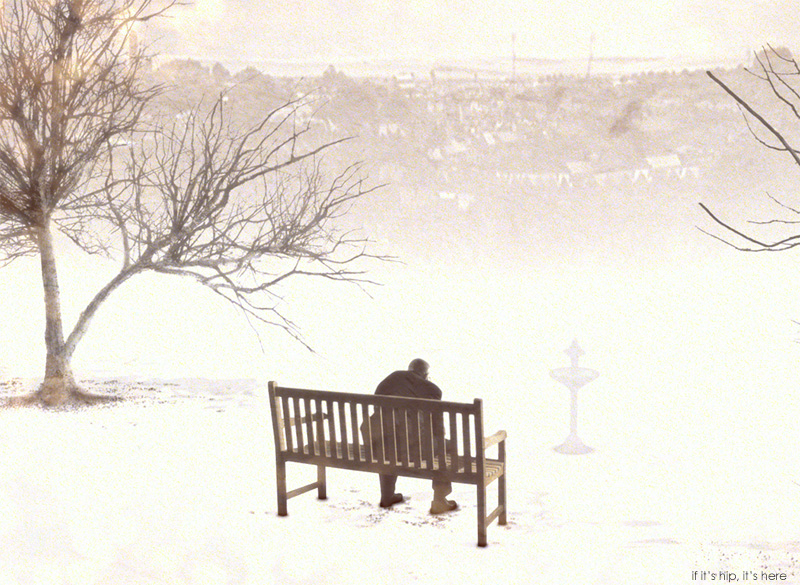About the author: Welshman Dylan Thomas who is best known for the poem “Do Not Go Gentle into That Good Night”, was born in 1914, in Swansea, Wales. In 1931, at the age 16, Dylan left school to become a junior reporter at the South Wales Daily Post; in 1932 he quit his job and turned his attention back to poetry. His poem “And Death Shall Have No Dominion” published in 1933 in the New English Weekly marked his first international publication. His first collection 18 Poems was published in 1934. It’s critically praised and received honors, including the 1934 Poet’s Corner Prize. In 1937 Thomas married Caitlin Macnamara 1937, and had two sons and a daughter. Due to the lack of his business
Due to the lack of his business sense he was relatively poor. In order to support his family, Thomas worked for the BBC and also as a film scriptwriter during World War II. He started doing reading tours to support his family financially, where his readings were more like a flamboyant performance than staid poetic events. He toured the United States four times; his last appearance was at the City College of New York in October 1953; after a long drinking bout at Manhattan’s White Horse Traven, Thomas collapsed at the Chelsea Hotel. Not long after the incident, on November 9, 1953, at the age of 53, Thomas died in a New York City hospital. The death had three probable causes: pneumonia, swelling of the brain and fatty liver.
Poetic Devices in Ferns by Dylan Thomas
PERSONIFICATION: Line 2: “lilting house”, lilting is an old school style of Gaelic singing, hence the house is personified.
Line 4 and 5: “Time” is personified as the speaker’s playmate.
Line 12: the sun has been personified and is defined as young.
Line 13: “time” is once again treated as the speaker’s friend.
Line 29: the farm is personified by the word “shoulder”.
ASSONANCE: Line 7: “trees” and “leaves” are vowel rhymes. They don’t rhyme perfectly, but the long “e” binds them together.
Line 8: “daisies” and “barley” are again vowel rhymes.
CONSONANCE: Line 9: “rivers” and “windfall” are consonant rhymes, where the “v” of rivers and “f” of windfall binds them together.
IMAGERY: Line 15: the speaker calls himself “green and golden” as a “huntsman and herdsman”.
ALLITERATION: Line 14: “mercy of his means”.
Line 15: “huntsman and herdsman”.
Line 16: “clear and cold”.
ANAPHORA: Line 21-23: the “and” is the word that these three lines begins with, this builds up the momentum of the poem.
SIMILE: Line 28: the farm is described as “a wanderer white/ with the dew”.
ALLUSION: Line 30: the call of Adam and Eve is a major allusion.
The poem is heavily dominated by the use of pastoral imagery, hence the use of colours like green and golden. The pastoral imagery enhances the imagination of the reader, and assists in the formation of a perfect image of the Fern Hill that the poet has been painting for the first five stanzas.
Fern Hill Summary by Dylan Thomas
The poem is more like a remembrance of the past life of the speaker. The six stanzas of the poem comprise of praising and then lamenting the days that the speaker has spent at Fern Hill as a youth. The poem displays the happiness of the young speaker and also points out how oblivious he was that youth was passing to never come back again. The initial happy and nostalgic tone of the poem undergoes a major shift at the end the poem, where from joy the poet redirects the mood of the poem to that of lamentation. There is a sudden realization of the reality that the speaker seems to face; the past that he was celebrating is nothing more than fleeting joy, neither his innocence nor those playful days will ever come back. At the very onset of the poem, the reader is made aware that the speaker is going on a ride to explore his childhood happy memories. The reader is taken to Fern Hill, one of the happy places from the speaker’s past, the mention of the “lilting house” and the pastoral scenery is a reflection of the speaker’s joy. Thomas has very skilfully used the words in the initial lines of the poem. Words like “starry” “dingle” are evidence that the poet is setting the mood of the poem. These lines have a cheerful cadence that’s the perfect fit for the cheerful meaning. In line number seven, when the speaker says “once below a time”, the sense of something foregone hits the reader, which anticipates the realization of the speaker as well. The happy image continues in the second stanza as well, where the speaker talks “about the happy yard and singing as the farm were home,”. Once again the feeling of carpe diem comes back in line twelve and thirteen when the speaker mentions the sun “that is young only once” and he prays time him “play and be/ Golden in the mercy of his means”. The discussion and description of his happy childhood days
At the very onset of the poem, the reader is made aware that the speaker is going on a ride to explore his childhood happy memories. The reader is taken to Fern Hill, one of the happy places from the speaker’s past, the mention of the “lilting house” and the pastoral scenery is a reflection of the speaker’s joy. Thomas has very skilfully used the words in the initial lines of the poem. Words like “starry” “dingle” are evidence that the poet is setting the mood of the poem. These lines have a cheerful cadence that’s the perfect fit for the cheerful meaning. In line number seven, when the speaker says “once below a time”, the sense of something foregone hits the reader, which anticipates the realization of the speaker as well. The happy image continues in the second stanza as well, where the speaker talks “about the happy yard and singing as the farm were home,”. Once again the feeling of carpe diem comes back in line twelve and thirteen when the speaker mentions the sun “that is young only once” and he prays time him “play and be/ Golden in the mercy of his means”. The discussion and description of his happy childhood days
Once again the feeling of carpe diem comes back in line twelve and thirteen when the speaker mentions the sun “that is young only once” and he prays time him “play and be/ Golden in the mercy of his means”. The discussion and description of his happy childhood days is continued in the third stanza as well; “Fields high as the house, the tunes from the chimneys” everything is a part of the speaker’s happy memories. The use of color in line twenty-two, enhances the pastoral imagery that heavily dominates the poem.in line twenty-four finally, the eventful and playful day of the speaker has come to an end as when the speaker “rode to sleep the owls were bearing the farm away,”. But the description of the night is pretty short as the playful day once again comes back in line twenty-eight and twenty-nine, where once again “the farm, like a wanderer white/ with the dew, come back, the cock on his shoulder: it was all”. Suddenly the poem calls on Adam and maiden Eve; hence the speaker draws a comparison between the farm and paradise. Stanza 5 moves towards the end of the poem, the poet is gradually drawing the point home. The poet talks about the sun which
Suddenly the poem calls on Adam and maiden Eve; hence the speaker draws a comparison between the farm and paradise. Stanza 5 moves towards the end of the poem, the poet is gradually drawing the point home. The poet talks about the sun which is “born over and over”, like something that will never die, the speaker says that he “ran my heedless ways”. To simply put it, the speaker was a carefree young boy, who did not pay much heed to anything else. This confession hits the reader who until now has witnessed the vivid description of every detail of the Fern Hill. In line forty-two finally, the speaker has come face to face with the truth of the present; he confesses that he back when he had time in his hand and the beauty of the Fern Hill he did not care much, but now he realizes the importance of those days. The last stanza elaborates on this same thought, as he says “Nothing I cared, in the lamb white days, that time would take me/ up to swallow thronged loft by the shadow of my hand/ in the moon that is always rising”. The last few lines are dominated by the carelessness with which the speaker had treated time and later he realized that he has woken “to the farm forever fled from the childless land”. The last three lines are the deep echo of the speaker’s realization and lamentation, as he realizes that when he was young though time had held him “green” and young, he was still dying and was moving towards his inevitable end, in this case, old age.
The last stanza elaborates on this same thought, as he says “Nothing I cared, in the lamb white days, that time would take me/ up to swallow thronged loft by the shadow of my hand/ in the moon that is always rising”. The last few lines are dominated by the carelessness with which the speaker had treated time and later he realized that he has woken “to the farm forever fled from the childless land”. The last three lines are the deep echo of the speaker’s realization and lamentation, as he realizes that when he was young though time had held him “green” and young, he was still dying and was moving towards his inevitable end, in this case, old age.
Fern Hill Analysis by Dylan Thomas
The poem has a theme that reminds us of “Tintern Abbey” by William Wordsworth. It has the same theme of nostalgia, recollection of the happy childhood memory which the poet yearns for but can’t possibly go back to ever. It has the same feeling of helplessness at the hand of the ever changing time which though once was the speaker’s playmate, has now taken away his youth from him; and the young speaker unaware of this mishap never paid any heed to the beauty he was being blessed with. The poem can be broadly divided into two primary parts, the first where the poet introduces and gives the reader a taste of the beauty of the Fern Hill in order to build the plot, for the final fall and the bitter truth- nothing remains the same, especially youth; second, where the poet makes a hurtful confession that he oblivious to the future and the loss of youth and the paradise like Fern Hill, never was enough considerate of it. Here it can be read as that even though the poet presents us with very intricate details about the “
Here it can be read as that even though the poet presents us with very intricate details about the “dingle”, still, it makes us think that perhaps back then, the poet too never noticed them, now, only being removed from it, he has come to notice it. The beauty that has been established in the previous five stanzas has suddenly and sorrowfully disappeared. Unlike the last time when he had woken up to the same “farm, like a wanderer white/ With the dew, come back”, this time he wakes up “to the farm forever fled from the childless land.” The poem is the journey of the speaker through the memory lane, which starts on a happy note travels through a lot of nostalgic moments and ends on a note of repentance of not being honest to the beautiful Fern Hill and lamentation of not getting back those happy days.
Tone of the poem: The tone of the poem is primarily a nostalgic one, which is dominated by other components such as lamentation of not getting back what has gone by, the repentance of not appreciating the youth and the beauty of Fern Hill and also to an extend the time which was back then his playmate, unlike now. There is no major shift in the tone of the poem until the last few lines, where the poem shifts from the happy memories to the sorrowful acceptance of the present.
Conclusion: The poem makes us nostalgic; it takes us to the speaker’s childhood along with himself. It makes us think, about our own childhood, it gives a sneak peek of the Fern Hill; the pastoral imagery that decorates the entire poem helps our imagination to paint the green Fern Hill. the poem also makes us aware that time, in the long run, takes away everything along with youth, the poet doesn’t forget to remind us that we, unlike, the poet should be more careful and appreciate the youth and its beauty.
Some online learning platforms provide certifications, while others are designed to simply grow your skills in your personal and professional life. Including Masterclass and Coursera, here are our recommendations for the best online learning platforms you can sign up for today.
The 7 Best Online Learning Platforms of 2022
- Best Overall: Coursera
- Best for Niche Topics: Udemy
- Best for Creative Fields: Skillshare
- Best for Celebrity Lessons: MasterClass
- Best for STEM: EdX
- Best for Career Building: Udacity
- Best for Data Learning: Pluralsight










